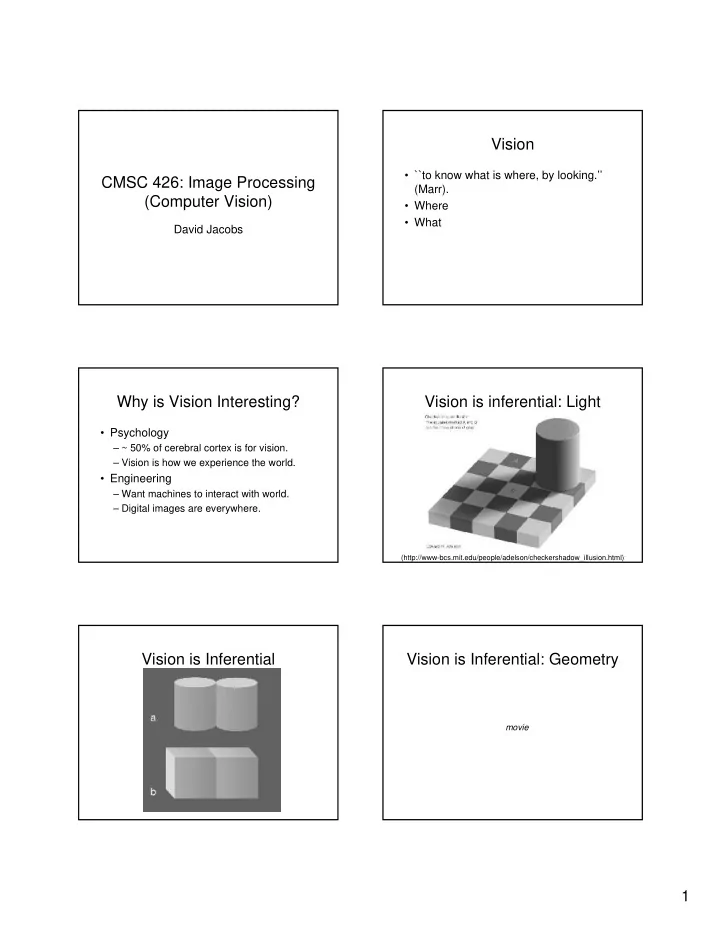

Vision • ``to know what is where, by looking.’’ CMSC 426: Image Processing (Marr). (Computer Vision) • Where • What David Jacobs Why is Vision Interesting? Vision is inferential: Light • Psychology – ~ 50% of cerebral cortex is for vision. – Vision is how we experience the world. • Engineering – Want machines to interact with world. – Digital images are everywhere. (http://www - bcs . mit . edu /people/ adelson / checkershadow _illusion.html) Vision is Inferential Vision is Inferential: Geometry movie 1
Vision is Inferential: Prior Vision is Inferential: Prior Knowledge Knowledge A Quick Tour of Computer Computer Vision Vision • Inference Computation • Building machines that see • Modeling biological perception Boundary Detection: Local Boundary Detection: Local cues cues 2
Boundary Detection (Sharon, Balun , Brandt, Basri ) http://www.robots.ox.ac. uk /~ vdg /dynamics.html Boundary Detection Finding the Corpus Callosum (G. Hamarneh , T. McInerney , D. Terzopoulos ) 3
Texture Texture Photo Photo Computer Generated Pattern Repeated Tracking Tracking ( Comaniciu and Meer ) (www. brickstream .com) Tracking Tracking 4
Tracking Tracking Stereo Stereo http://www. ai . mit . edu /courses/6.801/ lect /lect01_ darrell . pdf http://www. magiceye .com/ Stereo Motion http://www. magiceye .com/ http://www. ai . mit . edu /courses/6.801/ lect /lect01_ darrell . pdf 5
Motion - Application Pose Determination (www. realviz .com) Visually guided surgery Recognition - Shading Lighting affects appearance Classification ( Funkhauser , Min, Kazhdan , Chen, Halderman , Dobkin , Jacobs) 6
Vision depends on: • Geometry • Physics Approaches to Vision • The nature of objects in the world (This is the hardest part). Modeling + Algorithms Bayesian inference • Bayes law: P(A|B) = P(B|A)*P(A)/P(B). • Build a simple model of the world • P(world|image) = ( eg ., flat, uniform intensity). P(image|world )* P(world)/P(image ) • Find provably good algorithms. • P(image|world ) is computer graphics • Experiment on real world. – Geometry of projection. – Physics of light and reflection. • Update model. • P(world) means modeling objects in world. Problem: Too often models are simplistic Leads to statistical/learning approaches. or intractable. Problem: Too often probabilities can’t be known and are invented. Engineering Marr • Focus on definite tasks with clear • Theory of Computation requirements. • Representations and algorithms • Implementations. • Try ideas based on theory and get experience about what works. • Primal Sketch • Try to build reusable modules. • 2½D Sketch Problem: Solutions that work under • 3D Representations specific conditions may not generalize. Problem: Are things really so modular? 7
The State of Computer Vision The State of Computer Vision • Science • Technology – Study of intelligence seems to be hard. – Interesting applications: inspection, graphics, security, internet…. – Some interesting fundamental theory about specific problems. – Some successful companies. Largest ~100 - 200 million in revenues. Many in - – Limited insight into how these interact. house applications. – Future: growth in digital images exciting. Related Fields Contact Info • Graphics. “Vision is inverse graphics”. Prof : David Jacobs • Visual perception. Office : Room 4421, A.V. Williams Building (Next to CSIC). • Neuroscience. Phone: (301) 405 - 0679 • AI Email: djacobs@cs.umd.edu • Learning Homepage: http:// www.cs.umd.edu/~djacobs • Math: eg ., geometry, stochastic processes. TA : Hyoungjune Yi • Optimization. Email: aster@umiacs.umd.edu Tools Needed for Course Rough Syllabus • Math – Calculus – Linear Algebra (can be picked up). • Computer Science – Algorithms – Programming, we’ll use Matlab . • Signal Processing (we’ll teach a little). 8
Course Organization • Reading assignments in Forsyth & Ponce, plus some extras. • ~6 - 8 Problem sets - Programming and paper and pencil • Two quizzes, Final Exam. • Grading: Problem sets 30%, quizzes: first quiz 10%; second quiz 20%; final 40%. • Web page: www.cs.umd.edu/~djacobs/CMSC426/CMSC426.htm 9
This document was created with Win2PDF available at http://www.daneprairie.com. The unregistered version of Win2PDF is for evaluation or non-commercial use only.
Recommend
More recommend